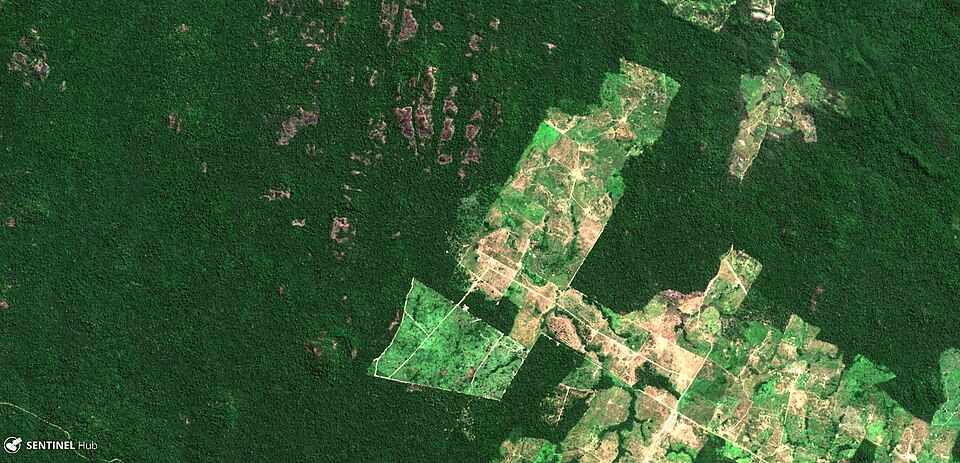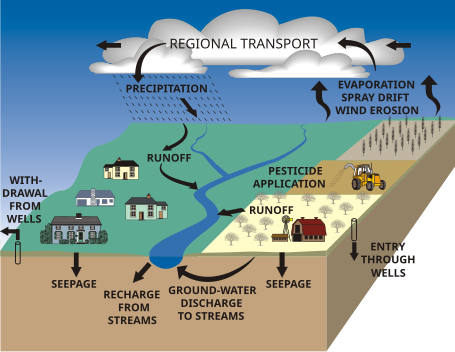OCR Specification focus:
‘Evaluate impacts of human population growth, agriculture including monoculture, and climate change on biodiversity at multiple scales.’
Biodiversity is influenced by multiple interacting factors. Human population expansion, agricultural practices, and climate change are the primary drivers reducing species diversity, habitat stability, and ecosystem resilience.
Human Population Growth and Biodiversity
Expanding Human Influence
As the global human population continues to rise, increasing demands for land, food, and resources exert severe pressure on natural ecosystems. This expansion results in habitat destruction, fragmentation, and pollution, each significantly diminishing biodiversity.
Habitat destruction occurs when natural environments such as forests, wetlands, and grasslands are cleared for housing, industry, or infrastructure.
Habitat fragmentation divides ecosystems into isolated patches, reducing gene flow between populations.
Pollution from urbanisation, industrial waste, and plastic contaminants alters soil, air, and water quality, often killing sensitive species.
Resource Exploitation
Overexploitation refers to unsustainable use of biological resources.
Overexploitation: The excessive harvesting of species or resources at a rate faster than they can naturally recover, leading to population declines and potential extinction.
Examples include overfishing marine species, illegal hunting, and unsustainable timber harvesting. Overexploitation often disrupts food webs, removing key predators or prey and destabilising ecosystems.
Urbanisation and Infrastructure
Urban sprawl converts previously biodiverse landscapes into artificial, low-diversity habitats. Roads and transport routes fragment ecosystems, making it difficult for animals to migrate or disperse seeds. This limits reproductive opportunities and increases the risk of local extinction.

Satellite imagery of Amazonian deforestation reveals a “fishbone” pattern where roads penetrate intact forest and spur further clearance. Such fragmentation reduces interior habitat, raises edge effects, and impedes movement of organisms between patches. Source.
Agriculture and Biodiversity
Agricultural Expansion
Modern agriculture is one of the greatest human pressures on biodiversity. As cropland expands, deforestation and drainage of wetlands eliminate natural habitats. Traditional mixed farming systems, which supported high species richness, are being replaced by intensive monocultures.
Monoculture and Its Consequences
Monoculture refers to the cultivation of a single crop species over large areas.
Monoculture: The agricultural practice of growing a single crop species across extensive land areas, reducing habitat and genetic diversity.
Consequences of monoculture include:
Reduced species richness: Fewer niches and food sources lead to lower biodiversity.
Vulnerability to pests and disease: Genetically similar plants lack resistance diversity, making crops prone to outbreaks.
Soil degradation: Continuous cultivation depletes nutrients, leading to soil erosion and loss of fertility.
Chemical pollution: The use of fertilisers and pesticides contaminates nearby ecosystems, reducing both terrestrial and aquatic species diversity.

A labelled diagram of pesticide pathways from fields to surface waters and groundwater via run-off, leaching, drainage tiles, and spray drift. Such contamination reduces aquatic invertebrate and plant diversity and can bioaccumulate up food webs. (Includes additional hydrological detail beyond the syllabus, but clarifies the mechanisms by which agriculture lowers biodiversity.) Source.
Agricultural Intensification
To increase yields, many farming systems depend on agrochemicals, irrigation, and mechanisation. While these practices enhance short-term productivity, they have negative ecological impacts:
Fertilisers cause eutrophication in aquatic systems, reducing oxygen availability and killing aquatic life.
Pesticides not only eliminate target pests but also harm non-target organisms, such as pollinators and soil microorganisms.
Irrigation can alter hydrological cycles, creating salinisation and affecting freshwater habitats.
Sustainable Agriculture
In contrast, sustainable agricultural practices—such as crop rotation, intercropping, organic farming, and agroforestry—maintain higher biodiversity. These methods improve soil structure, enhance nutrient cycling, and support pollinator diversity.
Climate Change and Biodiversity
Global Temperature and Weather Patterns
Climate change, driven by rising greenhouse gas emissions, alters global temperature and precipitation patterns. These environmental changes have far-reaching consequences for ecosystems.
Temperature increases shift species’ distribution ranges polewards or to higher altitudes.
Changes in rainfall patterns lead to droughts or flooding, altering freshwater and terrestrial habitats.
Ocean warming and acidification threaten coral reefs and marine biodiversity.
Phenological Changes
Phenology refers to the timing of biological events such as flowering, migration, or reproduction.
Phenology: The study of periodic biological events and their relationship to seasonal and climatic changes.
Climate change disrupts phenological synchrony, such as mismatches between flowering times and pollinator activity. These disruptions can reduce reproductive success and ecosystem productivity.
Species Range Shifts and Extinction
Some species can adapt or migrate in response to changing conditions, but many cannot. Those restricted by geographical barriers or specialised niches are at higher risk of extinction. Species with limited dispersal ability, such as amphibians or mountain plants, are particularly vulnerable.
Ecosystem-Level Impacts
Climate change alters community composition and ecosystem function. For instance:
Melting ice reduces polar habitats for species such as polar bears and penguins.
Increased frequency of wildfires destroys large areas of forest and grassland ecosystems.
Coral bleaching events, caused by ocean warming, result in loss of reef biodiversity.
Interactions Between Factors
Synergistic Effects
Human population growth, agriculture, and climate change often interact synergistically, amplifying their combined impact on biodiversity. For example:
Expanding populations increase food demand, promoting intensive agriculture.
Intensive agriculture contributes to greenhouse gas emissions, accelerating climate change.
Climate change then further reduces agricultural productivity, increasing pressure to convert new land.
Loss of Genetic and Habitat Diversity
These combined pressures reduce genetic diversity, the variety of genes within species, which is vital for adaptation to environmental change. Loss of habitat diversity—different ecosystems like wetlands, forests, and grasslands—reduces overall ecological resilience.
Positive Feedback Loops
Some changes reinforce themselves through positive feedback mechanisms. For instance, deforestation releases stored carbon, contributing to further warming, which then increases the risk of drought and wildfires—causing more deforestation.
Global and Local Scales of Impact
Local Scale
At local scales, biodiversity loss affects ecosystem services such as pollination, nutrient cycling, and soil stability. This can directly impact local communities’ food security and livelihoods.
Global Scale
Globally, biodiversity loss contributes to climate instability, reduces natural resources, and threatens sustainable development. International cooperation and conservation strategies are therefore essential to mitigate these effects.
FAQ
When forests are cleared, carbon stored in trees is released as carbon dioxide, enhancing the greenhouse effect and global warming.
Warmer, drier conditions can increase drought frequency and fire intensity, destroying more forests and vegetation.
This feedback loop accelerates habitat loss and species extinction, as each round of deforestation and warming amplifies the next.
Small or isolated habitats often support smaller populations with limited genetic variation.
This increases the risk of inbreeding and genetic drift, reducing adaptability to environmental change.
Fragmentation also raises the edge-to-area ratio, exposing interior species to predators, invasive species, and microclimate changes.
Overall, smaller fragments struggle to maintain viable populations over time.
Excess fertilisers, rich in nitrates and phosphates, are washed into rivers and lakes through surface run-off.
This causes eutrophication, leading to rapid algal growth that blocks sunlight and reduces oxygen levels as algae decompose.
Aquatic organisms such as fish and invertebrates may suffocate or migrate, while plant species adapted to clear waters disappear.
Climate change can cause phenological mismatches between plants and pollinators.
For example:
Plants may flower earlier due to warmer temperatures.
Pollinators, such as bees, might emerge later if triggered by day length rather than temperature.
This timing mismatch reduces pollination success, limiting seed and fruit production and affecting species that depend on those resources.
Sustainable practices aim to balance productivity with ecosystem health.
Examples include:
Crop rotation and intercropping, which reduce pest build-up and improve soil structure.
Agroforestry, where trees within fields provide habitats and maintain microclimates.
Reduced pesticide use and organic methods that preserve beneficial species.
By maintaining habitat complexity and soil fertility, these methods help conserve both species and genetic diversity in agricultural landscapes.
Practice Questions
Question 1 (2 marks)
State two ways in which agriculture can reduce biodiversity within an ecosystem.
Mark scheme:
One mark for each valid way stated (max 2 marks):
Removal of hedgerows or natural vegetation reducing habitat variety.
Use of pesticides killing non-target organisms.
Monoculture providing fewer niches and food sources for wildlife.
Fertiliser run-off causing eutrophication in nearby water bodies.
Question 2 (5 marks)
Explain how human population growth and climate change together can reduce biodiversity on a global scale.
Mark scheme:
Award marks for the following points, up to a maximum of 5:
(1 mark) Human population growth increases demand for land, food, and resources, leading to habitat destruction and fragmentation.
(1 mark) Expansion of urban areas and agriculture reduces habitat diversity and species richness.
(1 mark) Increased industrial and agricultural activity releases greenhouse gases, contributing to global climate change.
(1 mark) Climate change alters temperature and rainfall patterns, causing species range shifts or local extinctions.
(1 mark) The combined effects act synergistically—reduced habitats limit species’ ability to migrate or adapt to changing conditions, further accelerating biodiversity loss.
Accept any other valid examples showing clear linkage between human population growth, climate change, and biodiversity decline.

